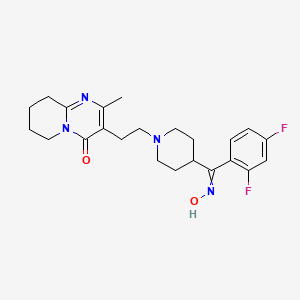
Risperidone E-Oxime
Vue d'ensemble
Description
Risperidone E-Oxime is a complex organic compound with potential applications in various fields such as chemistry, biology, medicine, and industry. This compound is characterized by its unique structure, which includes a difluorophenyl group, a piperidine ring, and a tetrahydropyridopyrimidinone core.
Méthodes De Préparation
Synthetic Routes and Reaction Conditions
The synthesis of Risperidone E-Oxime typically involves multiple steps, including the formation of the piperidine ring, the introduction of the difluorophenyl group, and the construction of the tetrahydropyridopyrimidinone core. Specific reaction conditions, such as temperature, pressure, and the use of catalysts, are crucial for the successful synthesis of this compound.
Industrial Production Methods
Industrial production methods for this compound may involve large-scale synthesis techniques, including continuous flow reactors and automated synthesis systems. These methods aim to optimize yield, purity, and cost-effectiveness while ensuring safety and environmental compliance.
Analyse Des Réactions Chimiques
Types of Reactions
Risperidone E-Oxime can undergo various chemical reactions, including:
Oxidation: The compound can be oxidized to form different oxidation states.
Reduction: Reduction reactions can modify the functional groups within the compound.
Substitution: Substitution reactions can introduce new functional groups or replace existing ones.
Common Reagents and Conditions
Common reagents used in these reactions include oxidizing agents (e.g., potassium permanganate), reducing agents (e.g., sodium borohydride), and various nucleophiles and electrophiles for substitution reactions. Reaction conditions such as solvent choice, temperature, and pH play a significant role in determining the outcome of these reactions.
Major Products Formed
The major products formed from these reactions depend on the specific reagents and conditions used. For example, oxidation may yield different oxidized derivatives, while substitution reactions can produce a variety of substituted analogs.
Applications De Recherche Scientifique
Chemistry
In chemistry, this compound can be used as a building block for the synthesis of more complex molecules. Its unique structure allows for the exploration of new chemical reactions and pathways.
Biology
In biological research, this compound may be used to study its interactions with various biological targets, such as enzymes and receptors. Its potential as a biochemical probe can provide insights into cellular processes and mechanisms.
Medicine
In medicine, Risperidone E-Oxime may have therapeutic potential due to its ability to interact with specific molecular targets. Research into its pharmacological properties could lead to the development of new drugs.
Industry
In industry, this compound can be used in the development of new materials, such as polymers and coatings. Its unique chemical properties may enhance the performance and durability of these materials.
Mécanisme D'action
The mechanism of action of Risperidone E-Oxime involves its interaction with specific molecular targets, such as enzymes or receptors. These interactions can modulate various biochemical pathways, leading to the compound’s observed effects. The exact molecular targets and pathways involved depend on the specific application and context of use.
Comparaison Avec Des Composés Similaires
Similar Compounds
- 2-{2-[(4-Methoxyphenoxy)methyl]phenyl}-4,4,5,5-tetramethyl-1,3,2-dioxaborolane
- N-(4-Ethoxybenzyl)-2-(4,4,5,5-tetramethyl-1,3,2-dioxaborolan-2-yl)benzenamine
- Spiropyrans
Uniqueness
Compared to these similar compounds, Risperidone E-Oxime stands out due to its unique combination of functional groups and structural features
Propriétés
Formule moléculaire |
C23H28F2N4O2 |
|---|---|
Poids moléculaire |
430.5 g/mol |
Nom IUPAC |
3-[2-[4-[C-(2,4-difluorophenyl)-N-hydroxycarbonimidoyl]piperidin-1-yl]ethyl]-2-methyl-6,7,8,9-tetrahydropyrido[1,2-a]pyrimidin-4-one |
InChI |
InChI=1S/C23H28F2N4O2/c1-15-18(23(30)29-10-3-2-4-21(29)26-15)9-13-28-11-7-16(8-12-28)22(27-31)19-6-5-17(24)14-20(19)25/h5-6,14,16,31H,2-4,7-13H2,1H3 |
Clé InChI |
BRCINVRBDDVLDW-UHFFFAOYSA-N |
SMILES canonique |
CC1=C(C(=O)N2CCCCC2=N1)CCN3CCC(CC3)C(=NO)C4=C(C=C(C=C4)F)F |
Origine du produit |
United States |
Synthesis routes and methods I
Procedure details









Synthesis routes and methods II
Procedure details







Synthesis routes and methods III
Procedure details







Avertissement et informations sur les produits de recherche in vitro
Veuillez noter que tous les articles et informations sur les produits présentés sur BenchChem sont destinés uniquement à des fins informatives. Les produits disponibles à l'achat sur BenchChem sont spécifiquement conçus pour des études in vitro, qui sont réalisées en dehors des organismes vivants. Les études in vitro, dérivées du terme latin "in verre", impliquent des expériences réalisées dans des environnements de laboratoire contrôlés à l'aide de cellules ou de tissus. Il est important de noter que ces produits ne sont pas classés comme médicaments et n'ont pas reçu l'approbation de la FDA pour la prévention, le traitement ou la guérison de toute condition médicale, affection ou maladie. Nous devons souligner que toute forme d'introduction corporelle de ces produits chez les humains ou les animaux est strictement interdite par la loi. Il est essentiel de respecter ces directives pour assurer la conformité aux normes légales et éthiques en matière de recherche et d'expérimentation.
![N-[2-(Chloroacetyl)-5-isopropylphenyl]acetamide](/img/structure/B8742109.png)
![Azepino[4,5-B]indole-5-carboxylic acid,1,2,3,4,5,6-hexahydro-3-(phenylmethyl)-,methyl ester](/img/structure/B8742128.png)

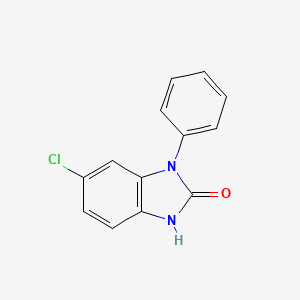

![8-Bromo-4,5-dihydrobenzo[b]thieno[2,3-d]oxepine-2-carboxylic acid](/img/structure/B8742163.png)
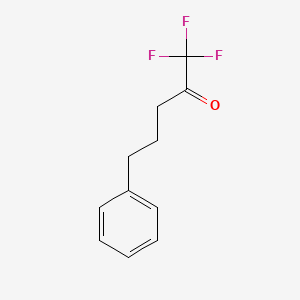

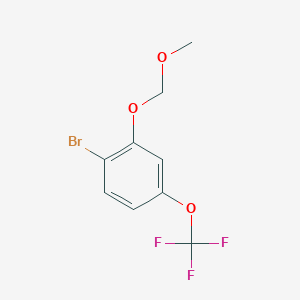

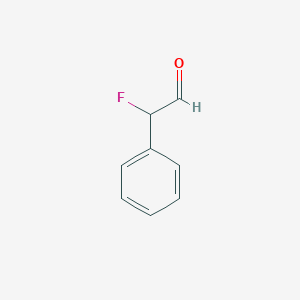

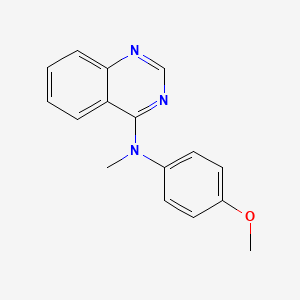
![1-Chloro-4-[(chloromethoxy)methyl]benzene](/img/structure/B8742236.png)
